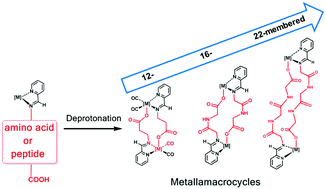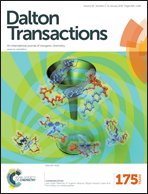Metallamacrocycle formation through dimerization of metal bioconjugates derived from amino acids and peptides†‡
Abstract
Metallamacrocycles of 12, 16, and 22 members are obtained by deprotonation of the carboxylic group of the side chain of iminopyridine complexes derived from the amino acid β-alanine, and the peptides Gly–Gly and Gly–Gly–Gly. Instead of the expected intramolecular attack to give tridentate (N,N,O) ligands, the deprotonated carboxylate attacks in an inter-molecular manner to give dimers in which the ligand acts as a bridge bonded in a κ2(N,N′) chelating fashion to one metal and as κ(O) to the other metal. The formation of the dimers is supported by NMR spectroscopy, mass spectrometry and X-ray crystallography.



 Please wait while we load your content...
Please wait while we load your content...